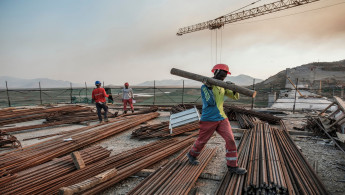Ethiopia says rising waters at mega-dam a 'natural' part of construction
Ethiopia on Wednesday acknowledged that water levels behind its mega-dam on the Blue Nile River were increasing, though officials said this was a natural part of the construction process.
The Grand Ethiopian Renaissance Dam (GERD) has been a source of tension in the Nile River basin ever since Ethiopia broke ground on it in 2011, with downstream countries Egypt and Sudan worried it will restrict vital water supplies.
Addis Ababa has long intended to begin filling the dam's reservoir this month, in the middle of its rainy season, though it has not said exactly when.
Cairo and Khartoum are pushing for the three countries to first reach an agreement on how it will be operated.
The latest round of tripartite talks overseen by the African Union has so far failed to resolve the dispute.
"The GERD water filling is being done in line with the dam's natural construction process," Seleshi Bekele, Ethiopia's water minister, was quoted by state media as saying Wednesday.
|
He did not, however, say whether Ethiopia had taken steps to store the water in the reservoir, which has a capacity of 74 billion cubic metres.
Ethiopia is in the middle of its rainy season, and an official at the dam site told AFP this week that heavy rains meant the flow of the Blue Nile was exceeding the capacity of the dam's culverts to push water downstream.
"We didn't close and nothing is done. It looks like, when you see some photos, it looks like the river is getting higher and higher because of the amount of water coming from upstream, which is above the charging capacity of the culverts," said the official, who spoke on condition of anonymity.
A separate official, an adviser at the water ministry who also insisted on anonymity, stressed that water continued to flow downstream.
"As the construction progresses, the water level behind the dam also will rise, so that's what's happening, nothing more," said the adviser.
Ethiopia has long insisted it must start filling the dam's reservoir this year as part of the construction process, though filling will occur in stages.
Prime Minister Abiy Ahmed reiterated the point in an address to parliament earlier this month.
"If Ethiopia doesn't fill the dam, it means Ethiopia has agreed to demolish the dam," he said.
"On other points we can reach an agreement slowly over time, but for the filling of the dam we can reach and sign an agreement this year."





 Follow the Middle East's top stories in English at The New Arab on Google News
Follow the Middle East's top stories in English at The New Arab on Google News


